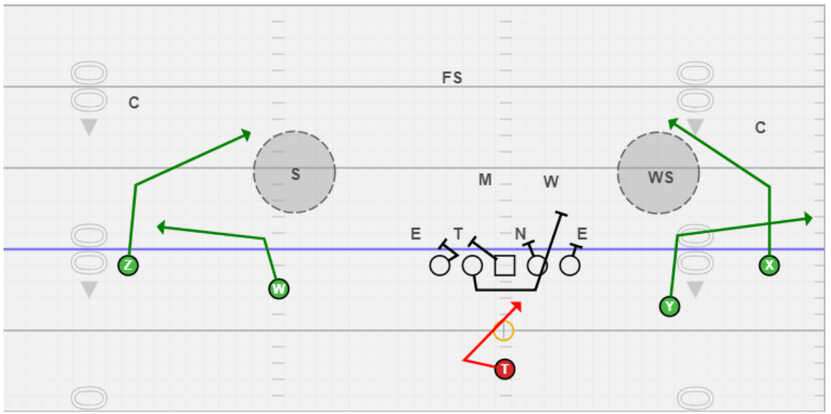Everything you need to know about RPOs

Here are the list of concepts you should tag a post-snap RPO with:
- Every single run play you have
- End of list
Actually, just to stay ahead of the game, tag an RPO on whatever you’re doing. Gotta go to the bathroom? Tag an RPO. Data entry for your job at a huge multinational corporation that you hate? Stick RPO. Tossing a salad? How about a tosser concept?
RELATED CONTENT: See how the sluggo-win concept works at the college and pro football levels
I’m the type of guy who wants to throw the ball every single play; however, I do understand the value of running the ball at the college or high school level where it’s harder to find elite quarterback play. RPOs give me the best of both worlds.
One of the problems with running the ball is the lack of explosive plays that come from the run game. Tagging a pass concept with your run gives your team the ability to gain the explosive plays you need to win football games.
Here’s a classic slant RPO on a conflicted linebacker:
RELATED CONTENT: How the Oregon Ducks utilized the triple option in their spread offense
College football’s analytical GOAT, Bill Connelly, found the teams that win the explosive play battle in a given game win that game 86 percent of the time. RPOs help to check that box. He also found that teams that win the efficiency battle win the game 83 percent of the time. RPO’s help to check that box by dealing with the unblocked defender in the run scheme and slowing his reads down. All of a sudden, your three-yard gains go for five yards and you can stay on track.
Here’s South Carolina coach Will Muschamp defending Missouri’s RPO-heavy offense by playing his extra linebacker at depth. He’s removed himself from immediately helping in the run game.

Dealing with the conflicted linebacker via the RPO gives you the same advantage that using your quarterback in the read run game gets you. Now, instead of having your quarterback take a bunch of shots while toting the rock, you give him a simple read in the pass game.
RPOs play against the ingrained nature of linebackers and defenders in general. From a very young age, we teach linebackers the read step and then to run with flow. They grow up a bit, and we still teach the read step, but now we ask them to read certain offensive linemen. They get triggered anytime they see any run scheme. RPOs play against that.
RELATED CONTENT: Check out how North Dakota State's diamond power read has contributed to the Bison's success
When you pull the ball from the running back’s gut on an RPO, all you’re doing is running a play action pass. Ben Baldwin found that in the NFL play action passing is a great (and underutilized) way to create big plays out of your offense:
“After working on this piece, one question that stands out is why teams seldom use play action from shotgun formations, especially on first-and-10 where the evidence is strongest that it works," the article said. "On first-and-10 from shotgun, play action passes have more yards per play (7.8 to 6.4) and target depth (9.2 to 8.2) than non-play action passes. And yet, only 14 percent of first-and-10 shotgun pass attempts use play action."
The next step is just to read any defender, conflicted or not. Some teams will just read whoever they damn well please. Safeties are fair game now, even if they aren’t a conflicted player.
Here's Sam Houston State running a little skinny post against a 1-high, aggressive safety:
I’ve seen seam RPOs where teams will read the seam defender in Cover-1 and -3 and throw the seam route if it’s open or else just hand the ball off. The Sam/Nickel might not be a conflicted player, but if he runs with the flat route on slant/flat, the ball whizzes past his head for a completion on the slant route.

.

What’s more, receivers don’t have to block as much. These guys already don’t really want to get dirty and block, so why force them when we can let them do what they’re there to do? We’ve seen these smashmouth spread teams tell their receivers not to just barely move off the line of scrimmage on certain plays. Just have these players run routes and everyone is happy.
RPOs have given me the impetus to actually want to call a run play which Seth Galina of five years ago would have scoffed at. What can RPOs do for you?
Follow Seth Galina on Twitter: @SethGalina
Want to see more content like this? Check out our Coaches Notes feature.
